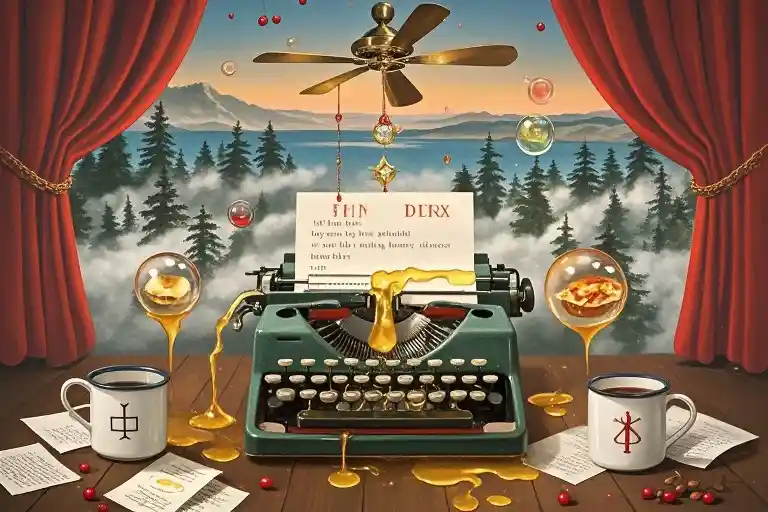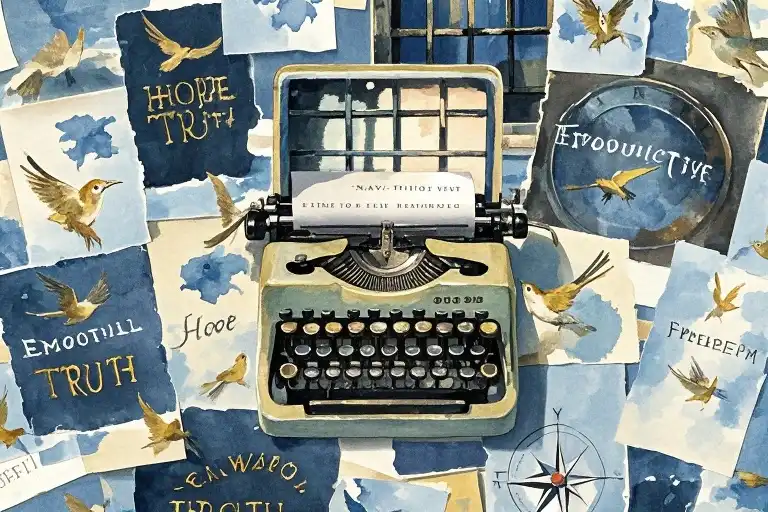Let me tell you a secret about storytelling they don’t teach in film school. It all began with a girl who never looked my way and a desperate 12-year-old’s fantasy. That’s right – my entire career pivots on a childhood crush so painfully awkward, it still makes me cringe/laugh decades later.
You know that girl who lives three houses down? The one who skateboarded past my lemonade stand every summer, her sunflower-yellow hair catching the light like something out of a Springsteen song? In real life, I might as well have been invisible. But on paper? Oh, in my handwritten notebook, I became the motorcycle-riding hero who saved her from mutant bikers and runaway ice cream trucks.
Funny how life works. That desperate act of literary wish-fulfillment became my first shaky step toward writing for Twin Peaks – the show that redefined TV storytelling. But we’ll get to the owls-that-aren’t-what-they-seem later. First, let’s talk about…
The Alchemist’s First Spell: Turning Rejection into Gold
Every writer’s origin story smells like teenage angst and library dust. Mine involved three crucial ingredients:
- A pile of Vonnegut/Salinger/Bradbury paperbacks by my bed
- A red notebook from Woolworth’s (price tag still attached)
- The crushing realization that reality needed…editing
Here’s the alchemy I discovered: Storytelling transforms life’s leaden disappointments into gold. Can’t get the girl? Write her into your adventure. Bullies mocking your Star Wars lunchbox? Make them intergalactic prison guards. It’s not escapism – it’s creative problem-solving with better dialogue.
Hollywood’s Crucible: Where Ideas Either Shine or Shatter
Fast-forward to my first real test: adapting Bret Easton Ellis’ Less Than Zero. Picture this – 23 years old, clutching a dog-eared manuscript outside a producer’s office, trying to translate cocaine-fueled LA nihilism into something watchable. The lesson? Adaptation isn’t translation – it’s organ transplantation. You keep the heart beating while grafting new limbs.
But the real education came in Twin Peaks‘ writers’ room – a place where logic went to die so magic could breathe. Let me show you our “madness map”:
| Reality Check | Lynchian Alchemy |
|---|---|
| Small-town murder | Cosmic evil in percolators |
| Police procedural | Dream logic interrogation |
| Love triangles | Doppelgänger romance |
We weren’t just breaking stories – we were performing narrative alchemy. David Lynch would arrive with coffee stains shaped like plot points, muttering about “the creamed corn of human suffering.” And somehow, this became television history.
3 Unwritten Rules of Lynchian Storytelling
- Milk the Mundane for Nightmares
That iconic ceiling fan in the Palmer house? We spent hours discussing its rotation speed. Why? Because hypnotic normalcy makes weirdness weirder. Tip: Take three ordinary objects in your scene and make one behave strangely. - Let Audiences Connect Their Own Dots
Remember the Log Lady? Her entire character emerged from a simple question: “What if someone’s best friend was a piece of wood?” We never explained – we charged that wood with meaning through lingering close-ups. Your homework: Create a mysterious object but never define its significance. - Embrace Productive Confusion
When viewers complained about being lost, David would smile and say “Good. Lost people look harder.” The Twin Peaks finale’s Red Room sequence was designed to resist decoding. Bold move? Absolutely. But it created watercooler moments that still echo 30 years later.
Failed Spells & Creative Resurrection
Now, let’s address the elephant in the room – Dracula. Our 2013 series had more identity crises than a vampire at a garlic festival. But here’s what failure taught me:
- A sinking ship needs lifeboats, not anchors (I became the crew’s designated “panic translator”)
- Tonal inconsistency kills atmosphere faster than sunlight
- Sometimes you need to embrace the cheese (My proudest moment? Convincing them to stage a blood orgy as Victorian performance art)
The takeaway? Bad writing teaches better than good writing. Every flawed scene contains a fossilized lesson about pacing, character motivation, or why certain actors shouldn’t handle swords.
Your Turn at the Cauldron: Practical Alchemy
Let’s transform your writing with three Twin Peaks-tested exercises:
- The Coffee Stain Method
Spill something on your notebook. Now build a character around the stain’s shape. Is it a country? A monster? A map to Atlantis? - Wrong Scene, Right Characters
Take your protagonist and drop them into a genre they don’t belong in. How would your serious lawyer character handle a zombie apocalypse? - The 2-AM Test
Write a dialogue scene where every line is something you’ve actually heard after midnight. Bonus points if it includes inexplicable laughter.
The Final Transmutation
That childhood crush? She eventually read my story – 20 years later at a high school reunion. Her verdict? “The motorcycle was cool, but real heroes notice when girls actually fall off skateboards.”
And that’s the ultimate alchemy. Our fictional worlds eventually shape reality – if we let them. The Red Room’s zig-zag floor? That started as a doodle to avoid writing act breaks. Laura Palmer’s haunting homecoming queen photo? Inspired by a yearbook I found covered in dust.
So here’s my challenge to you: Go write something dangerously personal. Let it be awkward, raw, and gloriously strange. Because somewhere between your most cringe-worthy truth and wildest imagination lies the next storytelling revolution.
P.S. That “mini”-lecture I promised? Let’s just say it involves 17 pages on the spiritual significance of cherry pie…
Want to Continue the Journey?
✍️ Share your most bizarre writing inspiration in the comments
🔮 Take our “Which Twin Peaks Character Writes Your Life?” quiz
📼 Download free vintage TV writing templates (includes actual coffee stains!)


